Physical Address
304 North Cardinal St.
Dorchester Center, MA 02124
The kidneys play an essential role in normal homeostasis. The key functions of the kidneys include:
Maintenance of normal body fluid composition . The kidney plays a primary role in the regulation of both the intracellular and extracellular compartments by retention or excretion of water and electrolytes. The concentration of water, sodium, potassium, calcium, phosphate, and hydrogen are tightly regulated within these body compartments to maintain normal cell size and cellular function.
Excretion of waste products of metabolism and excretion of foreign substances. The kidney is responsible for excretion of nitrogenous waste that is generated primarily in the liver from normal metabolism. In addition, a wide range of pharmacologic and exogenous toxic compounds are excreted in the urine.
Regulation of blood pressure . Reduced kidney perfusion or activation of the sympathetic nervous system stimulates the release of renin from the juxtaglomerular cells of the kidneys. This enzyme converts angiotensinogen to angiotensin I, which, in turn, is cleaved to form angiotensin II by angiotensin converting enzyme. Angiotensin II is a potent vasoconstrictive agent. In addition, this peptide hormone can stimulate sodium retention throughout the nephron, but especially in the proximal tubule. Angiotensin II also stimulates the release of aldosterone from the zona glomerulosa of the adrenal gland.
Production of hormones
Erythropoietin . Interstitial fibroblasts produce erythropoietin in response to the hypoxia inducible factor (HIF). Erythropoietin is a glycoprotein hormone that promotes maturation of progenitor erythroid cells into mature red blood cells in the bone marrow.
Activation of vitamin D. The final hydroxylation of vitamin D to its active form, 1,25-dihydroxy vitamin D, is achieved by the proximal tubule cells in response to parathyroid hormone. This steroid hormone plays an essential role in calcium and phosphate homeostasis, as well as bone metabolism.
The kidney is the master regulator of homeostasis. Despite substantial variations in intake, environmental conditions, or physical stresses from one individual to another or within the same individual over the course of a few hours, the kidney maintains normal body fluid composition and plasma volume. Important examples include:
Normal water concentration dictates cell size since water is distributed equally in all body compartments according to the distribution of solute.
Normal sodium content affects extracellular volume, a key component of which is intravascular volume, organ perfusion, and blood pressure.
Restriction of potassium primarily to the intracellular space maintains the electrochemical gradient necessary to maintain the negative cell membrane potential required for cells to function normally.
Normal homeostasis of hydrogen concentration affects protein folding and enzymatic function.
Since the kidney maintains plasma volume and plays a role in red blood cell production, the kidney also controls the intravascular volume.
To maintain normal volume and body fluid composition, the kidneys must maintain balance, or “the steady state.” Thus, intake and production via metabolism must always equal excretion and consumption. Under normal circumstances, excretion can readily match intake. For example, an increase in water intake normally prompts excretion of water as dilute urine. Intake of a diet rich in potassium can stimulate excretion of a large amount of potassium. Similarly, intake of a high-protein diet can prompt excretion of additional nitrogen and acid, but in the setting of volume depletion or reduced kidney function, these prompt responses may be blunted.
The human body is composed primarily of water; in adult men, approximately 60% of the lean body weight is water, with a slightly lower percentage in women and children who tend to have slightly more adipose tissue that contains less water than muscle. Water is distributed among the body compartments such that approximately two-thirds is in the intracellular space and one-third in the extracellular space ( Fig. 1.1 ). The extracellular fluid is composed of the interstitium and the vascular fluid. These latter compartments are essentially in continuum; fluid in the vasculature is separated from the interstitium only by small differences in oncotic forces generated by plasma proteins and cells. Typical values for the normal electrolytes in plasma and intracellular fluid are shown in Table 1.1 .
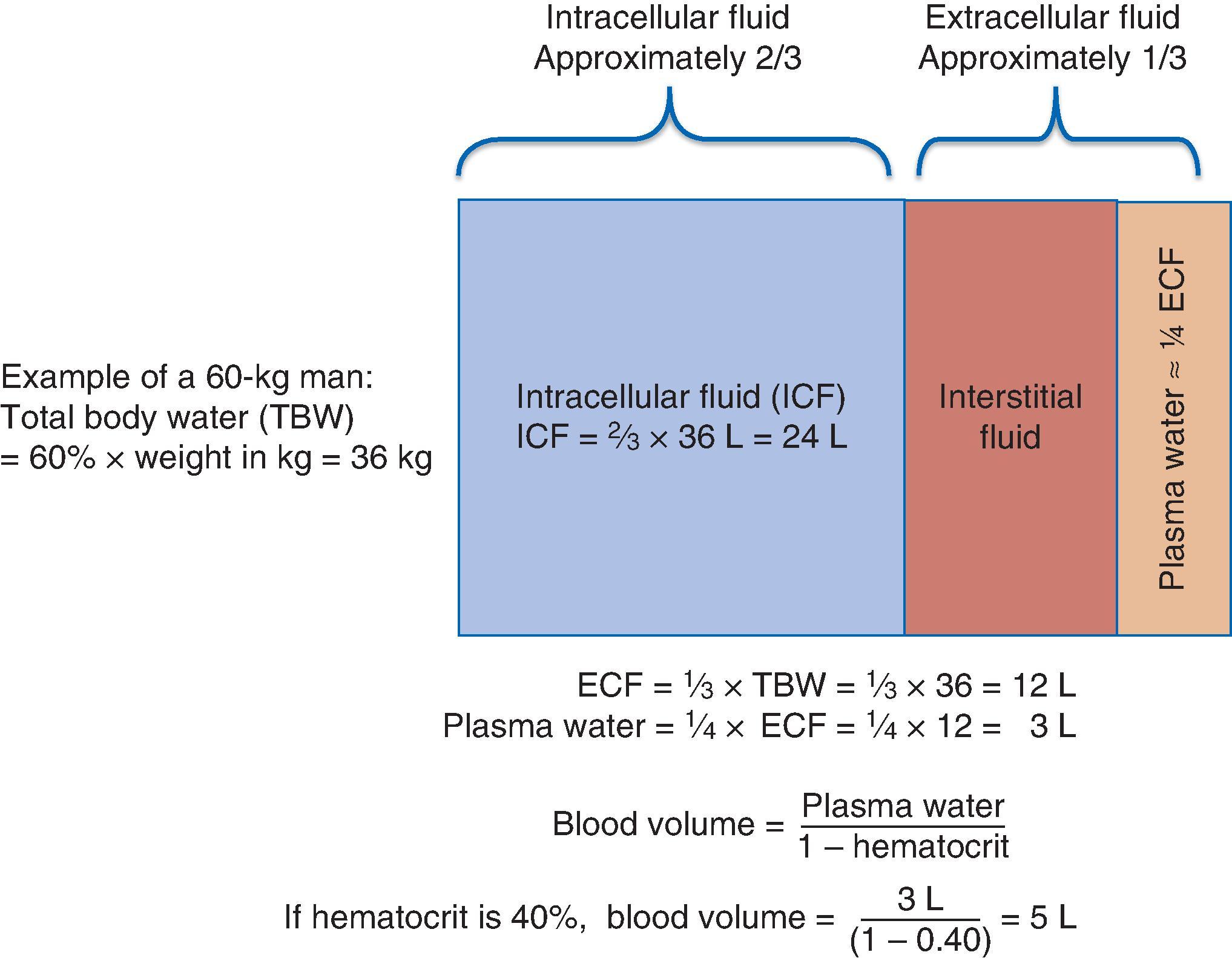
| Plasma (mEq/L) | Intracellular Fluid (mEq/L) | |
| Cations | ||
| Na + | 138 | 8 |
| K + | 4 | 135 |
| Ca 2+ (ionized) | 2 | <0.0001 |
| Mg 2+ | 1 | 2 |
| Total cations | 145 | 145 |
| Anions | ||
| Cl − | 104 | 4 |
| HCO 3 − | 24 | 10 |
| HPO 4 2− , H 2 PO 4 − | 2 | 40 |
| Protein | 10 | 50 |
| Other (organic anions and SO 4 2− ) | 5 | 41 |
| Total anions | 145 | 145 |
| Osmolality | 290 mOsm/L | 290 mOsm/L |
| pH | 7.4 | 7.1 |
The kidneys are positioned along the posterior abdominal wall of the retroperitoneum, each weighing approximately 150 g. Anatomically, the kidneys are divided into two regions: an outer cortex and an inner medulla ( Fig. 1.2 ). The cortex and medulla contain the basic functional units of the kidney, the nephrons, as well as the associated vasculature, nerves, and lymphatic vessels. The nephron consists of the glomerulus, Bowman’s capsule, and the renal tubule ( Fig. 1.3 ). On average, each kidney comprises 1 million nephrons, but this number may vary in individuals, from approximately 600,000 to 2 million nephrons per kidney. Distinct functional units form the renal tubule—the proximal tubule, the loop of Henle, the distal convoluted tubule, and the collecting duct. The function and morphology of the tubular epithelium vary in each segment of the nephron (see below). The glomeruli, most of the proximal tubule, and portions of the distal tubule are primarily located in the cortex. The medulla is composed of parallel arrays of the loops of Henle and collecting ducts. On gross inspection, these parallel arrays form the renal pyramids. The rounded apices of the pyramids form the papilla. The urine is maximally concentrated in the renal medulla, and the concentration of solute in the medullary interstitium may exceed that of plasma fourfold.
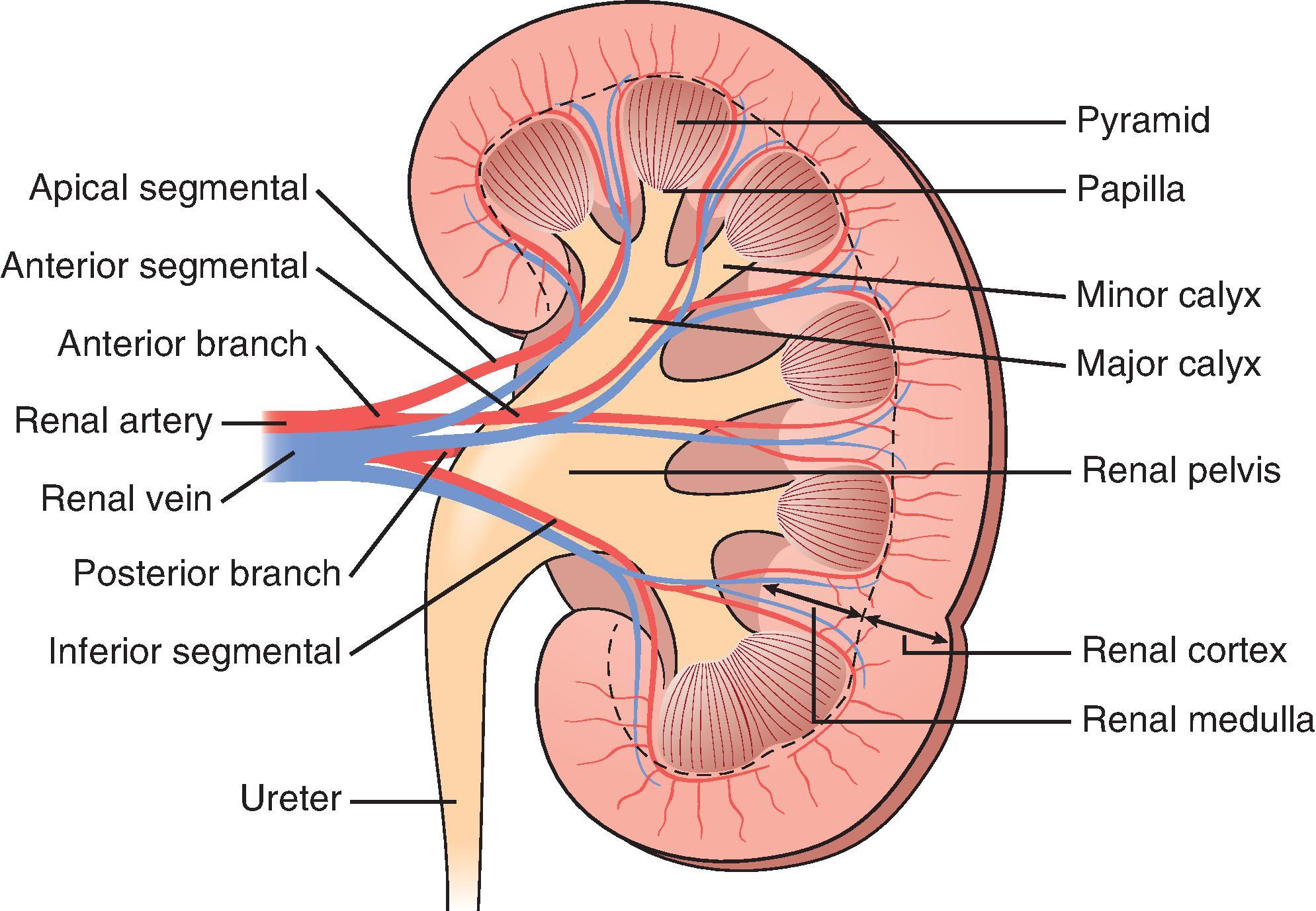
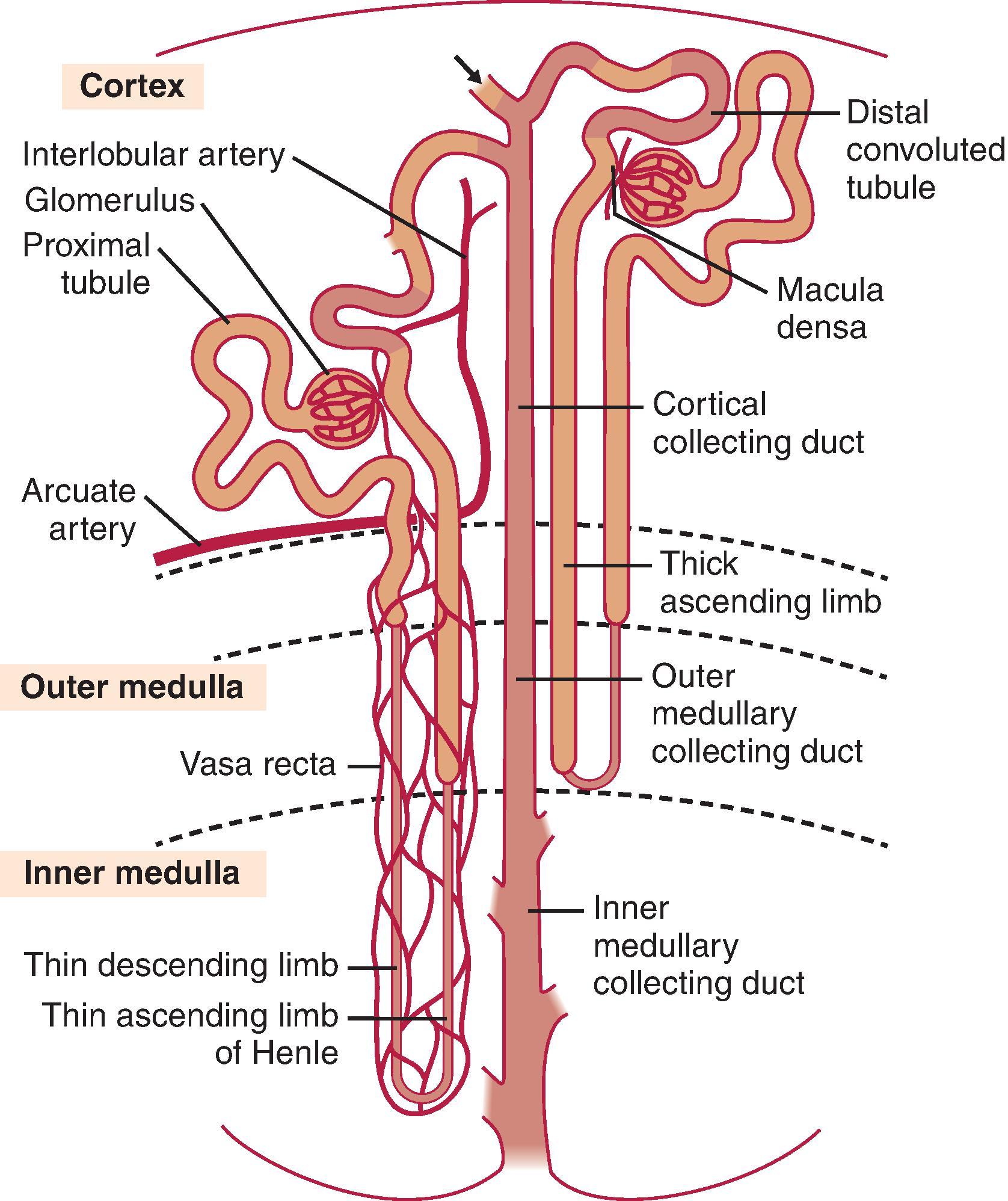
The process of urine formation begins at the glomerulus. The glomerular filtrate flows into Bowman’s capsule and enters into the proximal tubule, where about two-thirds of the filtrate is reabsorbed. Tubular fluid then flows through the thin descending limb of the loop of Henle, and, after a hairpin turn, ascends through the thin ascending limb into the thick ascending limb (TAL) of the loop of Henle. The distal portion of the loop of Henle touches the glomerulus at the juxtaglomerular apparatus (JGA), after which the filtrate flows into the distal convoluted tubule. Fluid in the tubular lumen is maximally dilute at this site. The processed filtrate then flows via the connecting tubule into the cortical and medullary collecting ducts where water is either conserved or excreted. The collecting duct is also the regulatory site of potassium and hydrogen ion secretion. As the filtrate passes through each successive portion of the nephron, a highly orchestrated process of solute reabsorption and secretion occurs that results in the excretion of the precise amount water, acid-base equivalents, and electrolytes necessary to maintain homeostasis. Urine subsequently passes from the papillae (the tips of the pyramids) into the minor calyces, which then converge to form two to three major calyces that configure the renal pelvis. The lining of the renal pelvis, the ureter, bladder, and urethra is comprised of transitional epithelial cells that are impermeable to water. In the urethra, squamous epithelial cells, which are also impermeable to water, line the lumen.
The renal circulation is one of the richest vascular beds in the body. The renal arteries originate from the lateral aspect of the aorta and enter the kidneys in the hilum, posterior to the renal veins and anterior to the origin of the ureter. Anatomic variants of the renal arteries and veins are common and can be found in 25% to 40% of patients. During development, blood from transient aortic “sprouts” supplies the kidneys; these degenerate as the kidneys ascend and renal arteries from the lumbar region ultimately perfuse the kidneys. When arteries from earlier in development do not degenerate, there may be residual additional vessels.
The renal arteries enter the kidney in the hilum and then bifurcate first into segmental arteries (see Fig. 1.2 ). The segmental arteries are functional “end arteries” since they serve as the only supply of oxygenated blood to their particular regions of the kidney. The segmental arteries then divide into interlobar arteries , and then arcuate arteries , which arch around the kidney as they run between the cortex and the outer medulla; the arcuate arteries give rise to the interlobular arteries that extend toward the cortex and, en route, give rise to an array of arterioles. The afferent arterioles divide into the glomerular capillaries and then culminate in another arteriole, the efferent arteriole . Thus, the glomerular capillary is the only capillary bed in the body flanked by two resistance vessels. Changes in the resistance of the arterioles can affect glomerular pressure and ultimately filtration.
The efferent arterioles then descend toward the medulla and form a second capillary bed; these capillaries are associated with the proximal tubules and are known as the peritubular capillaries . The intimate association between this second capillary bed and the tubules creates a relationship such that filtration and reabsorption can be balanced. For example, if filtration is increased, tubular reabsorption is also increased. This is called glomerulotubular balance .
The peritubular capillaries continue straight to the medulla and are called the vasa recta. The vasa recta then take a hairpin turn and return to the cortex (see Fig. 1.3 ). This orientation allows the kidney to return electrolytes and water to the circulation while maintaining the concentration gradient that is created by the loops of Henle. Red blood cells that travel in the vasa recta are subjected to very low oxygen tension and a hyperosmotic environment in the medulla. To withstand the osmotic stress, red blood cells have transporters for urea on the cell surface that allow urea to rapidly enter the cells and help maintain cell size and structure (see below).
The glomerulus is a complex network of capillaries responsible for the selective ultrafiltration of plasma and the clearance of small solutes. The glomerular capillaries are uniquely interposed between two arterioles: the afferent and efferent arterioles. This anatomic configuration allows for the intricate control of glomerular capillary pressure and the glomerular filtration rate (GFR). The glomerular capillaries form the glomerular filtration barrier ( Fig. 1.4 ), which allows for the selective filtration of small solutes such as water, sodium, and urea, while excluding the passage of cells and large proteins such as albumin. The basement membrane, endothelium, and podocytes confer a net negative charge to the filtration barrier. As a result, negatively charged proteins such as albumin are less likely to pass through the filtration barrier. Under normal conditions, only low-molecular-weight proteins and a small amount of albumin are filtered; these are almost completely reabsorbed and catabolized by the proximal tubular epithelial cells. This leads to excretion of 40 to 80 mg of protein per day, primarily composed of uromodulin (previously known as Tamm-Horsfall protein ), a mucoprotein secreted by tubular epithelial cells in the thick ascending loop of Henle.
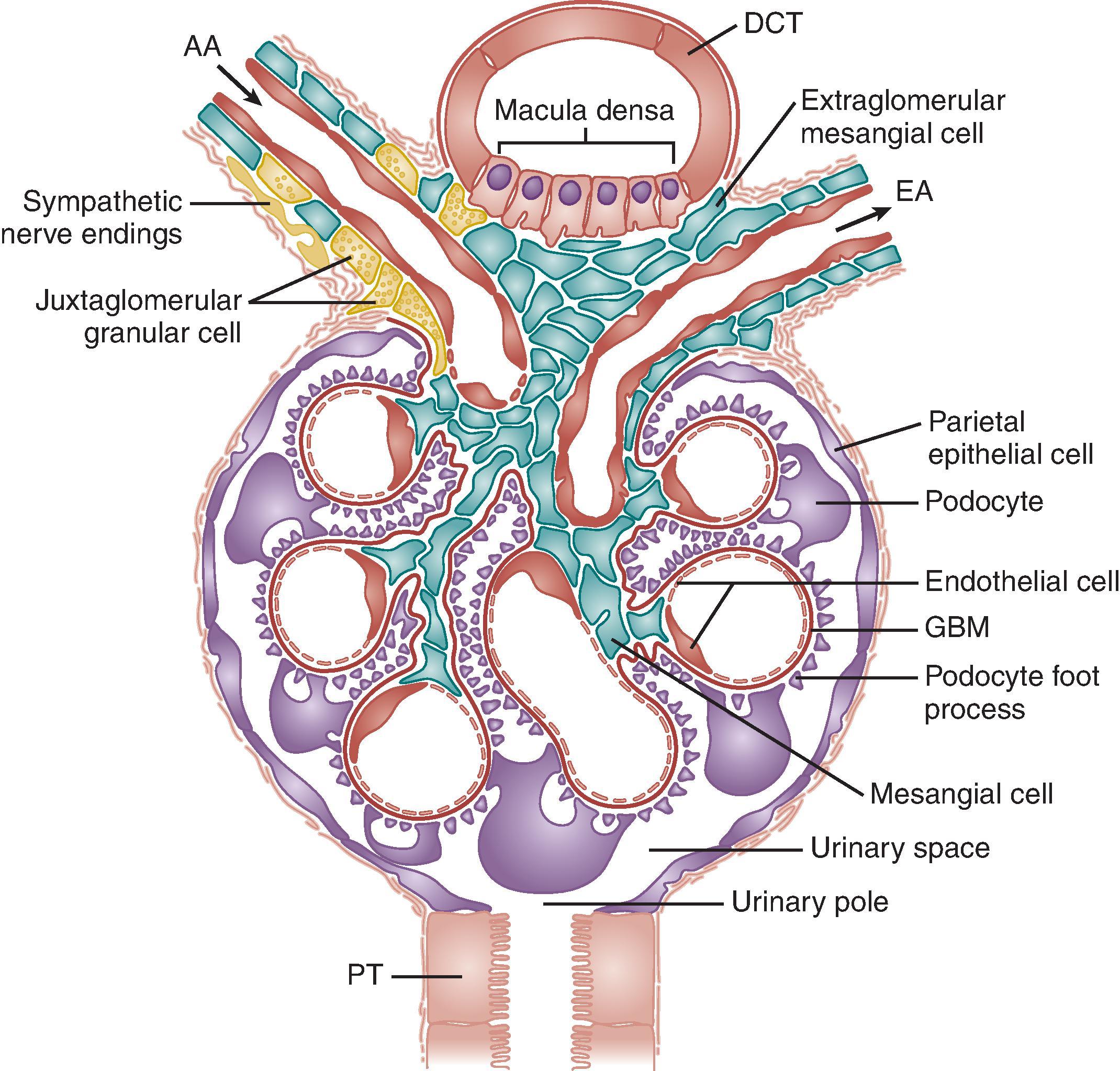
The glomerulus has four major components: the endothelium, the mesangium, the basement membrane, and the podocytes ( Fig. 1.5 ). In addition to important functional roles, the mesangium and podocytes provide a structural scaffold that supports the glomerular capillaries. The glomerular capillaries have an unusually high proportion of fenestrae , or clefts, on the endothelial surface (20% to 50%) that facilitate the efficient trafficking of small solutes and water through the filtration barrier. The glycocalyx is a lattice of negatively charged glycoproteins that overlies the fenestrae that preferentially exclude the passage of negatively charged proteins such as albumin. Aligned between the endothelial cells and the podocytes is the basement membrane. This structure is composed of a network of extracellular matrix proteins that include type IV collagen, laminin, and heparan sulfate-bound proteoglycans. The basement membrane constrains the filtration of proteins in concert with the endothelium and podocytes and has an important role in limiting the flux of solutes and fluids. The visceral epithelium is composed of podocytes, specialized cells named for the foot processes that envelop the glomerular capillaries. The foot processes of one podocyte interdigitate with foot processes from neighboring podocytes to form the filtration slit diaphragm. These specialized intercellular junctions function as a critical barrier to the passage of high-molecular-weight proteins. Podocin and nephrin are two constituent proteins of the filtration slit diaphragm essential for the proper structure and function of the filtration barrier. Inactivating mutations of the genes that encode podocin and nephrin lead to severe proteinuric kidney disease.
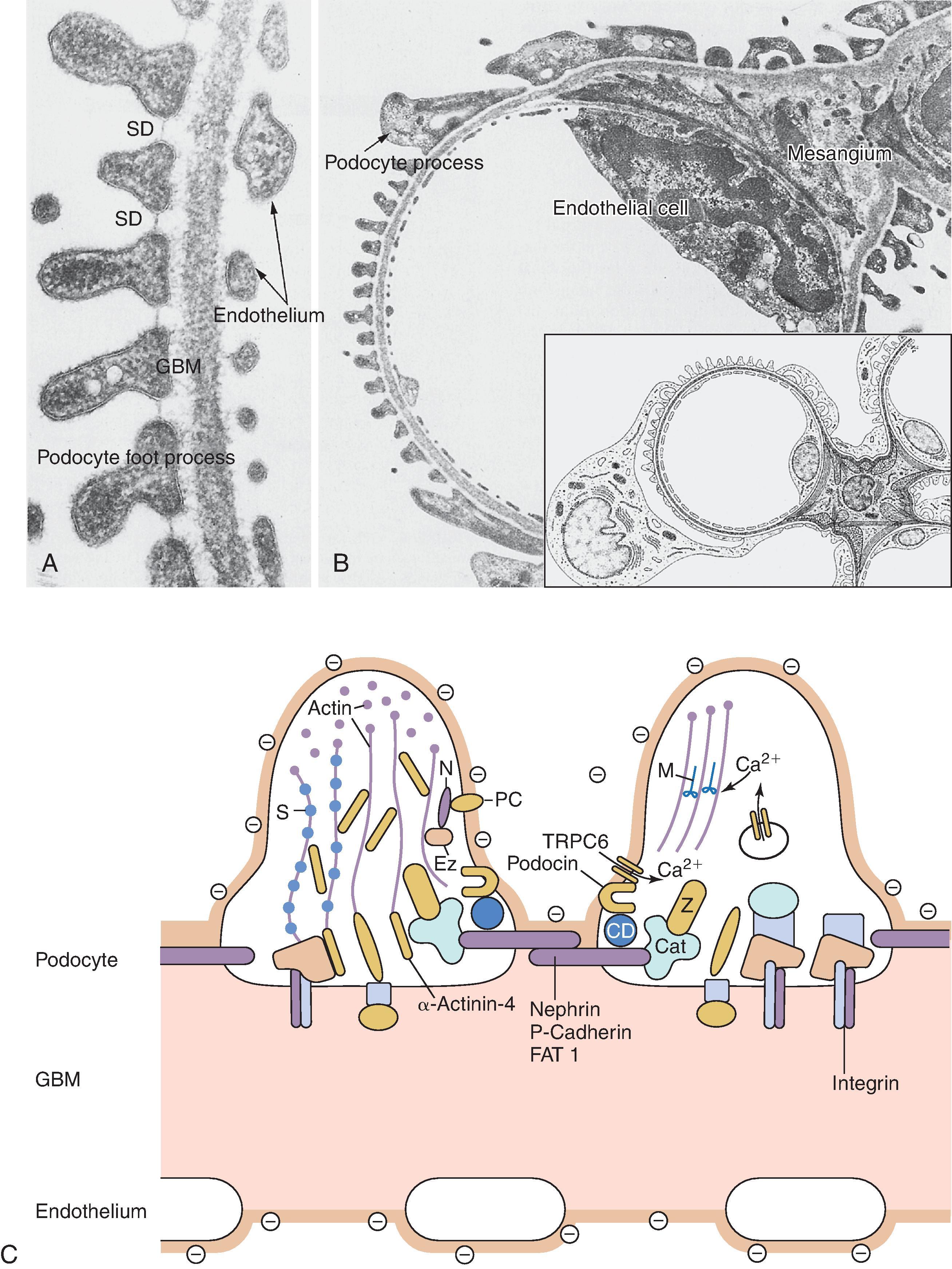
The GFR is the product of the net filtration pressure along the glomerular capillary (P net ) and the surface area of the glomerular capillaries. This relationship can be represented by the following equation:
Transcapillary Starling forces are key determinants of the net filtration pressure. These include the glomerular capillary hydraulic (P cap ) and oncotic pressure (π cap ) and the interstitial hydraulic (P int ) and oncotic pressures (π int ). The net filtration pressure can be altered by the permeability of the glomerular capillary (represented by the filtration coefficient, K f ), and the net oncotic pressure may be influenced by the permeability of proteins across the capillary wall, denoted by the refection coefficient (σ). Quantitatively, these forces are related by the following equation:
The hydraulic pressure at the origin of the glomerular capillary bed is relatively high, at approximately 60 mm Hg, and exceeds the capillary oncotic pressure throughout the length of the glomerular capillaries. Together with a very high filtration coefficient, the relatively high glomerular capillary pressure favors the net filtration of fluid from the glomerular capillaries into Bowman’s space. The capillary oncotic pressure increases along the length of the capillary as filtration of relatively protein-free fluid progresses, resulting in a gradual fall in net filtration pressure as filtration proceeds toward the efferent arteriole. The GFR typically equals about 20% of the plasma flow rate. Changes in GFR can result from altered glomerular capillary pressure or permeability or from a change in the surface area of the glomerular capillaries. The relative resistance of the afferent and efferent arterioles affects changes in renal plasma flow, net ultrafiltration pressure, and GFR. A number of physiologic mediators can alter the degree of constriction or dilation of these arterioles. Angiotensin II, increased activity of the sympathetic nervous system, and circulating catecholamines cause arteriolar vasoconstriction, whereas prostaglandins, nitric oxide, and bradykinin mediate arteriolar vasodilation. During decreases in renal perfusion, prostaglandins tend to maintain or increase glomerular capillary pressure and GFR by causing afferent arteriolar vasodilatation. Correspondingly, in the normal range of autoregulation of GFR (a perfusion pressure of 80 to 180 mm Hg), angiotensin II maintains glomerular capillary pressure and GFR when there is a relative decline in perfusion by inducing vasoconstriction of the efferent arteriole.
Measurement and estimation of the GFR are extensively reviewed in Chapter 3. The GFR is equal to the total plasma ultrafiltration rate. Normal values are about 120 mL/min/1.73 m 2 body surface area (BSA) for adult women and 130 mL/min/1.73 m 2 BSA for adult men, or about 180 L/day. GFR progressively increases with growth during childhood and declines about 1 mL/min/year starting at age 40. GFR can be measured indirectly by determining the clearance of a solute, such as inulin, that is freely filtered by the glomerulus and is neither secreted nor reabsorbed by the renal tubules. In addition, the solute should not be produced or metabolized by the kidney. When these conditions are met, the filtered load is equivalent to the excreted load, allowing for the calculation of GFR.
Creatinine is an endogenous solute commonly used to estimate GFR. Creatinine clearance is less precise than inulin clearance in determining GFR because approximately 10% to 40% of urinary creatinine is derived from the tubular secretion of creatinine in the proximal convoluted tubule. As a result, creatinine clearance tends to overestimate GFR by about 10% to 15%. The degree of overestimation increases at lower levels of GFR in which the tubular secretion of creatinine is proportionately higher. The serum creatinine level can also be used to assess GFR either alone or through use of estimating equations. As discussed in Chapter 3, the serum creatinine level has limitations for GFR estimation, varying with muscle mass, dietary intake, comorbid illness, age, sex, and volume status. Other filtration markers, like cystatin C, can also be used to estimate GFR. Cystatin C is less influenced by age, sex, and muscle mass compared with serum creatinine and better estimates kidney function at higher levels of GFR.
The JGA is a conglomeration of structures central to the regulation of GFR, sodium chloride balance, and extracellular fluid volume. The JGA is comprised of:
a segment of the distal convoluted tubule called the macula densa (see below),
the afferent arteriole of its own glomerulus,
the smooth muscle cells of these arterioles, and
specialized granular cells in the wall of the afferent arteriole.
The granular cells release renin in response to decreased perfusion or increased sympathetic tone. In addition, decreased delivery of sodium and chloride to the kidney-specific Na + /K + /2Cl − cotransporter (NKCC2) in the macula densa signals the granular cells to release renin.
The JGA plays an important role in the intrarenal regulation of renal blood flow and GFR. Autoregulatory mechanisms stabilize renal blood flow and GFR during changes in renal perfusion pressure in the range of 80 to 180 mm Hg. Small changes in renal perfusion can influence GFR and potentially cause life-threatening changes in sodium balance. In the absence of significant changes in the effective arterial blood volume (EABV) or underlying kidney disease, two servomechanisms prevent alterations in sodium balance during spontaneous or induced fluctuations in renal perfusion. The first, a rapid myogenic response modulates changes in renal blood flow and GFR after small changes in renal perfusion. Increased hydraulic pressure at the afferent arteriole triggers the intracellular release of calcium that leads to compensatory vasoconstriction. A more delayed mechanism, tubuloglomerular feedback , adjusts sodium excretion in response to variations in renal perfusion in the range of renal autoregulation. An increase in renal perfusion pressure will lead to an increase in single-nephron GFR and an increase in the filtered load of sodium chloride. The resultant increase in sodium chloride delivery to the macula densa results in increased NKCC2 activity and this elicits a signal that constricts the afferent arteriole and increases preglomerular vascular resistance. This feedback mechanism counteracts increases in single-nephron GFR arising from increased renal perfusion. In contrast, a decrease in renal perfusion pressure leads to a decrease in the single-nephron GFR and a decrease in the filtered load of sodium chloride. The resultant decreased delivery to the macula densa results in a decrease in NKCC2 activity and this signals the granular cells to release renin. Tubuloglomerular feedback is likely altered in chronic kidney disease based on models of chronic nephron loss. Increased tubular sodium chloride levels at the macula densa, for example, result in increased, not decreased, single-nephron GFR in rats after subtotal nephrectomy.
The volume of the initial glomerular filtrate is approximately 180 L/day in the setting of a normal GFR as derived above, yet most individuals excrete just 1 to 2 L of urine a day. A circuit of tubules, lined with epithelial cells, reabsorbs the majority of the filtrate and assures that the final urine has the appropriate amount of electrolytes, acid, and water.
Since cells are bound by a lipid bilayer and are impermeable to large molecules, ions, and polar molecules, transport proteins within the epithelial cell membrane help overcome this barrier and facilitate the movement of substances from the filtrate back to the capillaries. The renal tubular cells are polarized cells, characterized by the presence of the Na + /K + -ATPase on the basolateral membrane. The Na + /K + -ATPase generates an approximately 10-fold higher level of sodium in the extracellular fluid than the intracellular fluid by extruding three intracellular sodium ions in exchange for two extracellular potassium ions with energy derived from the hydrolysis of ATP. This is an example of primary active transport . In contrast, transporters on the luminal membrane benefit from the low intracellular concentration of sodium function based on secondary active transport . This arrangement allows the kidney to use the concentration gradient created by the low intracellular sodium concentration to reabsorb the majority of sodium in the filtrate.
Movement of sodium into the cell can be achieved with coupled transport of sodium either in the form of cotransport, as with the sodium/glucose cotransporters, or in the form of countertransport, as with the Na + /H + -exchanger (see below). Facilitated transport using carriers in the membrane can facilitate the movement of molecules such as glucose and urea. Specialized channels favor movement of specific ions along with their electrochemical gradient. The aquaporin water channels permit water to move along the osmotic gradient.
Tight junctions are present between the tubular epithelial cells. These junctions limit paracellular transport so that gradients can be established between the urinary filtrate and the interstitium. These tight junctions are composed of multiple proteins, including claudins, occludins, and cadherins, which permit selective transport of certain ions.
The tubular segments vary substantially in both function and morphology. The proximal tubule reabsorbs the bulk of the filtrate, the loop of Henle creates the concentration gradient that is present in the medulla, and the distal nephron sets the final urine composition.
The proximal tubule is the workhorse of the kidney, and more than 60% of the filtrate is normally reabsorbed in this region. The first portion of the proximal tubule is convoluted and forms a labyrinth within the renal cortex before transitioning to a straight segment that leads to the loop of Henle. To achieve the task of reabsorbing the bulk of the urinary filtrate, the proximal tubule has a lush luminal brush border of microvilli that increases the surface area dramatically ( Fig. 1.6 ). The primary transporter for sodium on the luminal membrane is the Na + /H + -exchanger 3 (NHE3). This antiporter also plays a key role in the reclamation of bicarbonate (see below). In addition, NH 4 + formed in the proximal tubules from glutamine is excreted via the same transporter, as the molar radius of NH 4 + is similar to that of H + . Other important transporters in the proximal tubule include the Na + /phosphate cotransporters regulated by parathyroid hormone, sodium/glucose transporters, and amino acid transporters. These cells are permeable to water due to the presence of aquaporin 1, and water is reabsorbed in an isosmotic fashion. Tight junctions between proximal tubule cells allow passive reabsorption of water along with paracellular movement of chloride and potassium.
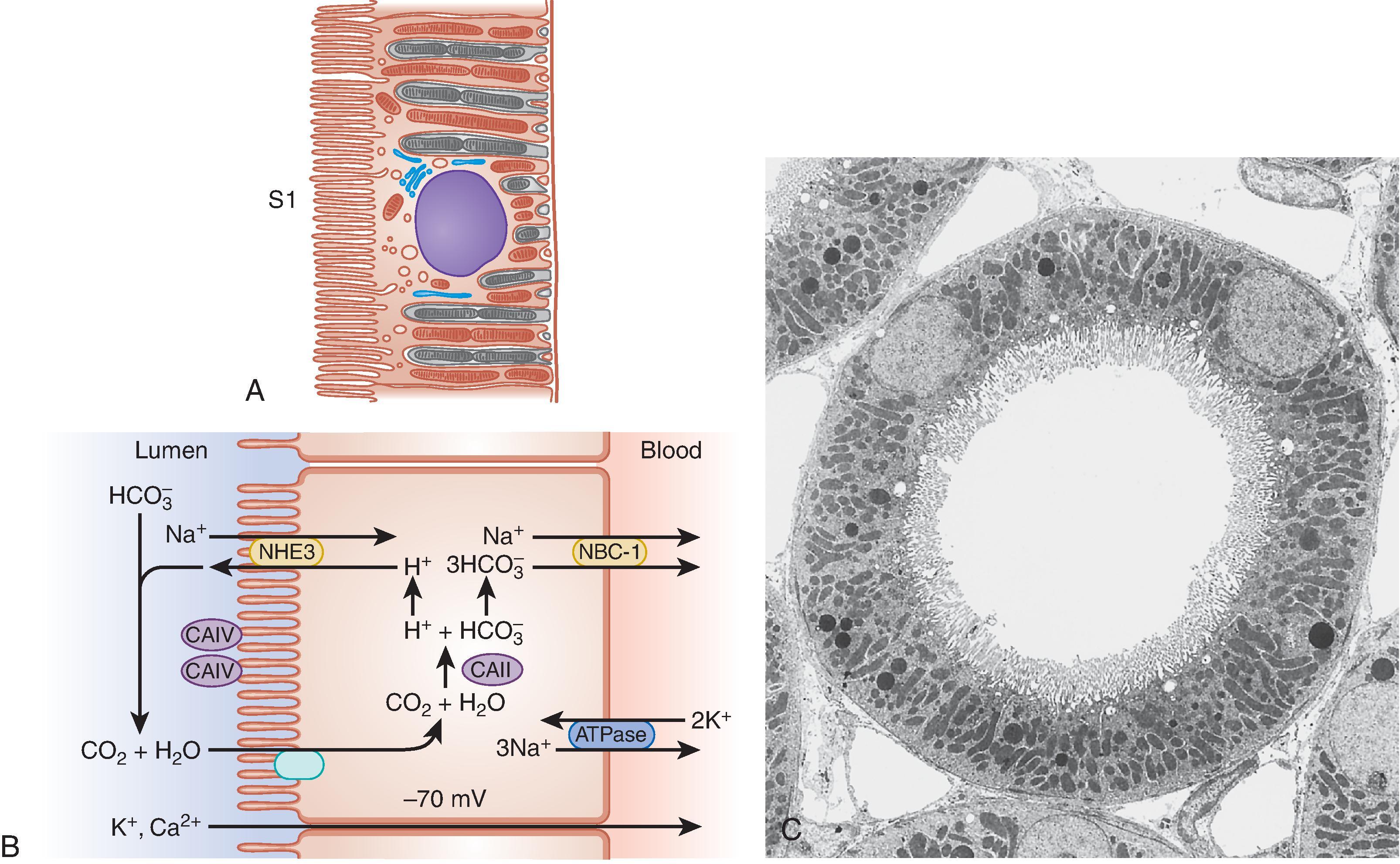
At the end of the proximal tubule, the cell type abruptly changes to that of the thin descending limb of Henle ( Fig. 1.7 ). After a hairpin turn, the thin ascending limb of Henle becomes the taller TAL, equipped with the renal-specific NKCC2. NKCC2 requires all four ions for transport. Since the concentration of potassium in the lumen is considerably lower than that of sodium and chloride, additional potassium is supplied by a channel that allows movement of potassium into the lumen, the renal outer medullary potassium channel (ROMK) ( Fig. 1.8 ). NKCC2 plays a critical role in the creation of the medullary concentration gradient. Also of note, the versatile ammonium ion, NH 4 + , can be absorbed by NKCC2 in the K + position. The thin limbs are permeable to water, but the TAL cells are not. This differential permeability, along with active transport by the TAL, plays an important role in the development of the medullary gradient within the kidney. For this reason, the loop of Henle is considered the concentrating segment of the nephron. The net result is that the concentration of the medulla of the kidney is much higher than the rest of the body. This is the only compartment in the body that has a higher osmolality than serum.
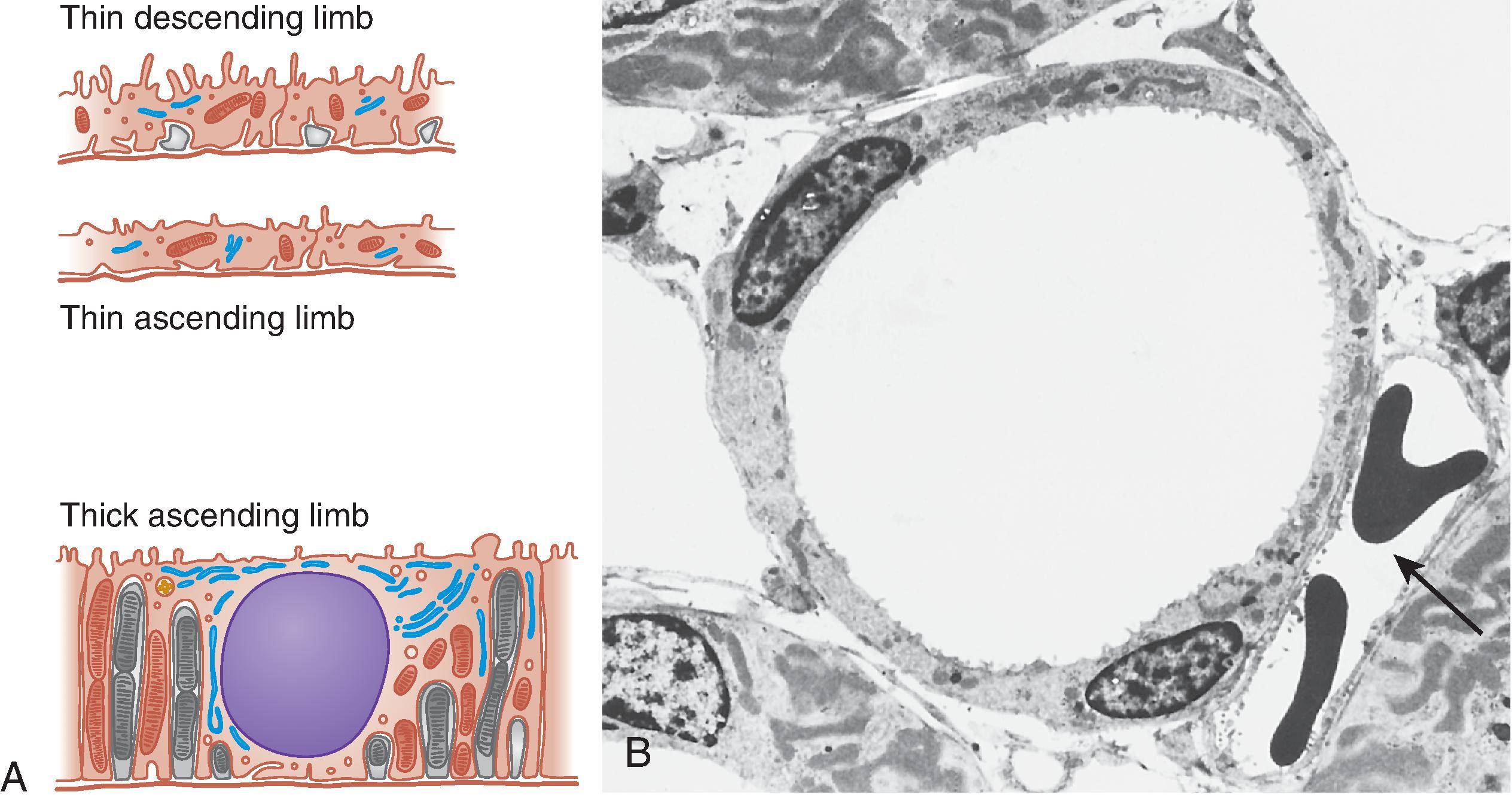
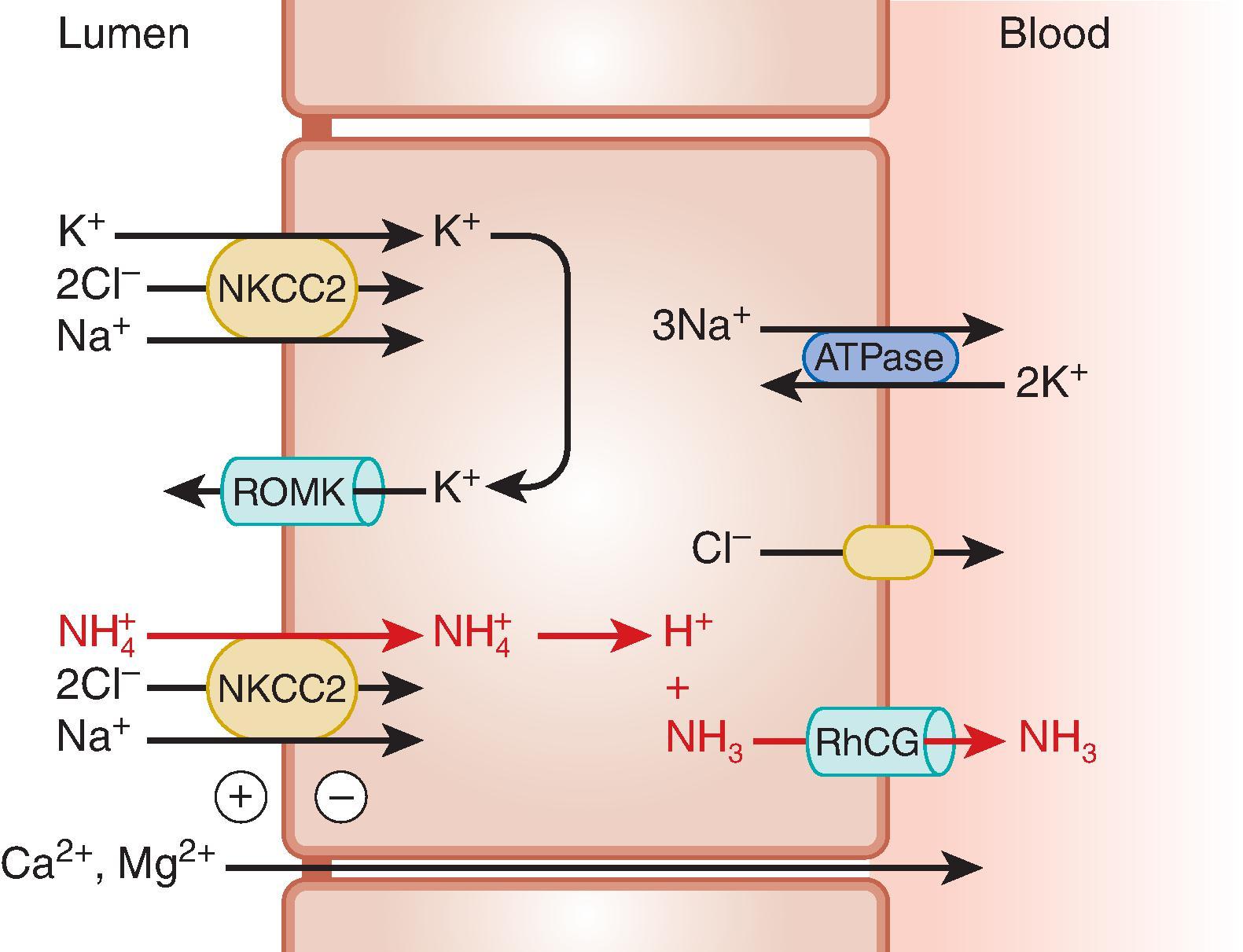
When the loop of Henle reaches the cortex, it greets its own glomerulus and transitions into a unique structure called the macula densa. Specialized cells in this structure are equipped with the same NKCC that is used here to provide feedback regarding tubular flow to the parent glomerulus as described above.
Become a Clinical Tree membership for Full access and enjoy Unlimited articles
If you are a member. Log in here